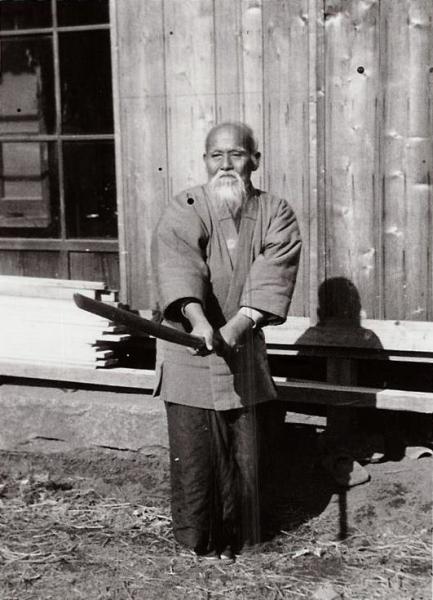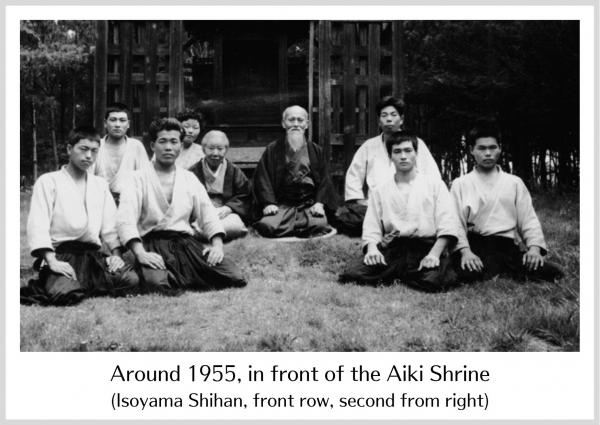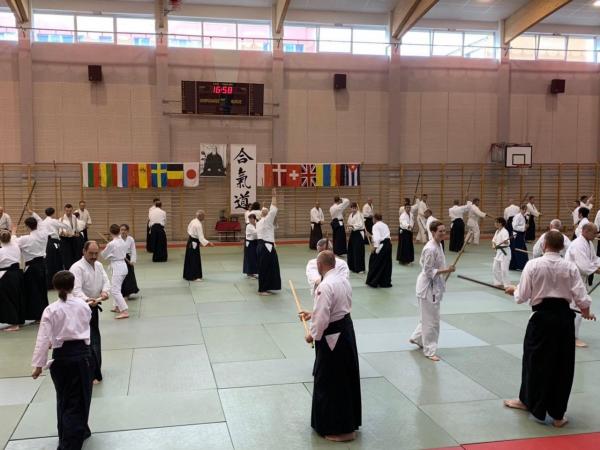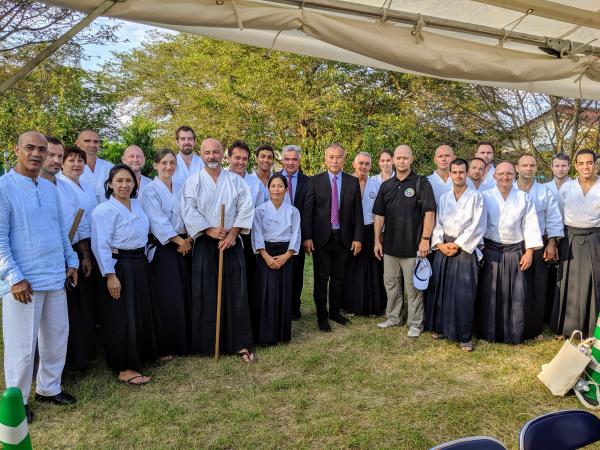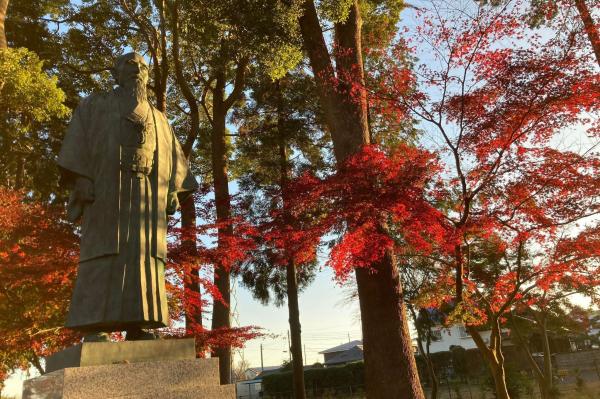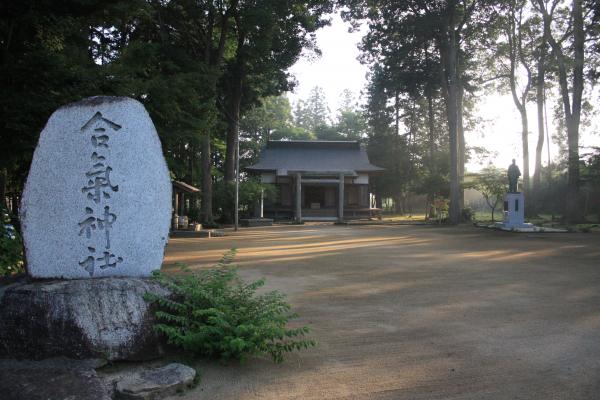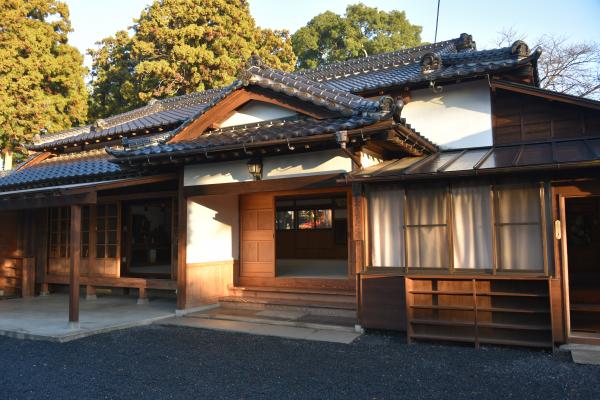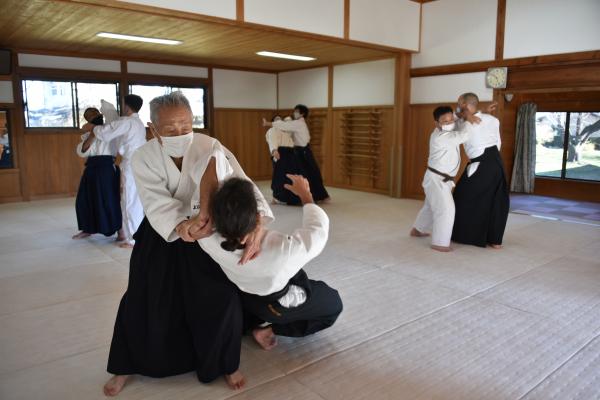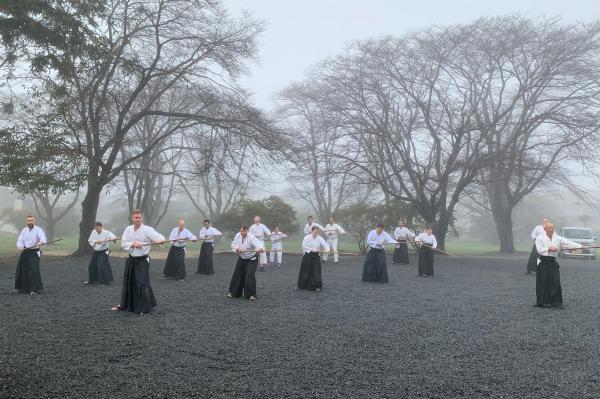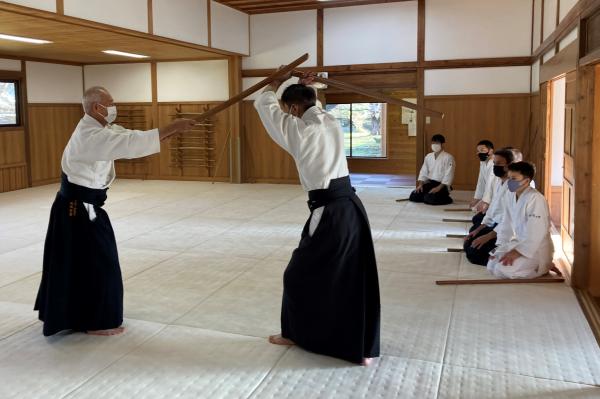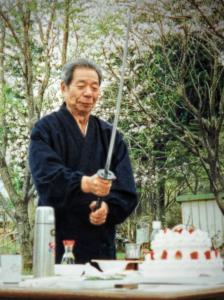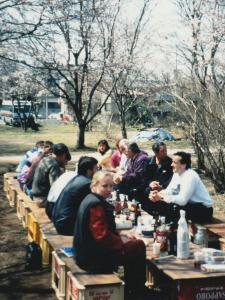The Aikido Founder’s Place of Practice (合気道開祖、修練の地)
Kasama Magazine March 2023 Special Edition "The Aikido Founder’s Place of Practice" (Japanese)
The Aiki Shrine and dojo established by Ueshiba Morihei, the founder of aikido, are located in Kasama City, and the founder spent a long time here in ascetic training while farming, so this is a place with a very deep connection to aikido. At the east gate of JR Iwama Station, a bust of the founder and five monuments bearing the founder’s photograph and doka poems were installed. Also, there is a bronze statue of the founder in the grounds of the world’s only Aiki Shrine.
What is Aikido?
Aikido is a modern budo (martial way) established by the founder, Ueshiba Morihei, through devotion to all kinds of traditional Japanese martial art as well as spiritual self-improvement.
Since there is no goal to contest about who is better, there are no competitions. By adhering to an attitude of respect for each other, aikido can be practiced by anyone regardless of age, gender, or nationality.
Introducing the Poems of the Way
The founder left many doka (poems of the way). Here is one of them.
『美しき この天地の御姿は 主のつくりし 一家なりけり』
(Uruwashiki kono ametsuchi no misugata wa nushi no tsukuri shi ikka narikeri)
There were many attempts to translate it into English. Here is one of them:
"So beautiful, the form of this Heaven and Earth
created by the lord to be a member of the one family"
It means that everything on this earth was made by god and that everyone is one family. It can be said that through aikido training, we learn how to have a heart of harmony, and this is something that will also lead to world peace.
A Short Biography of Ueshiba Morihei
Places Connected to Aikido
The aikido founder, Ueshiba Morihei was born in 1883 in Nishinotani Town, Nishimuro District, Wakayama Prefecture. At around the age of 29, he immigrated to Shirataki Village in Monbetsu District, Hokkaido as colony leader. There, he met Mr. Takeda Sokaku of Daito-ryu jujutsu and endeavored to train in budo (the martial way) for seven years while working as a colonist. Following that, in 1919, he moved to Ayabe Town in Kyoto Prefecture where he received teachings from the religious leader Deguchi Onisaburo. He opened the 'Ueshiba Juku' (School) and practiced there for about seven years. In 1931, he opened a dojo dedicated to aikido called the 'Kobukan' in Shinjuku District, Tokyo, and began instructing there.
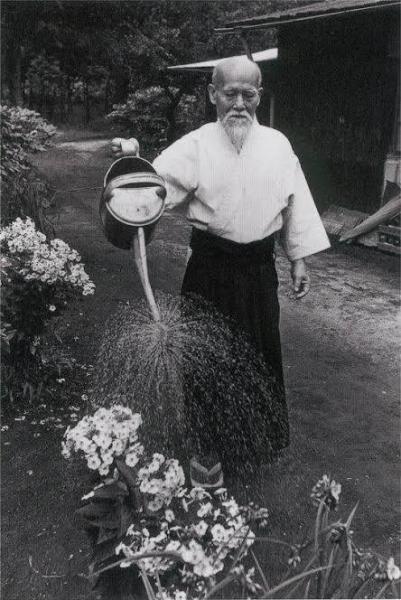
From around 1935 he began purchasing land in Iwama Town, and when he moved there in 1942 he had about 20,000 tsubos (about 6.6 hectares).
At the time, the founder already had three purposes he had wished to implement for quite some time.
-
To construct the Aiki Shrine
-
To establish an outdoor dojo; train in aikido and pass it on to his heart’s content
-
To live a life with the union of budo and agriculture
After the war, Ueshiba came and went between the Tokyo Aikido Hombu Dojo and his land in Iwama, training and developing his students. Iwama, where he lived for 27 years, is a place with a deep connection to aikido.
Friendship Cities
In May 2001, Tanabe City, Engaru Town (Shirataki Village at that time), and Kasama City (Iwama Town at that time) signed a Friendship City Agreement as places with a deep connection to the aikido founder. On February 23, 2008, Ayabe City joined the agreement, and all four municipalities newly exchanged Friendship City Declarations.
Interview with a Direct Student of Ueshiba Morihei
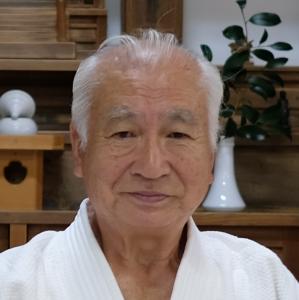
Isoyama Hiroshi (磯山 博)
Aikikai Ibaraki Branch Dojo Consultant
Aikikai Hombu Shihan
Aikido 8th dan with over 73 years of aikido experience
How you got started
I enrolled in 1949, at that time, unlike now, getting into fights was commonplace.
As a twelve-year-old who didn’t want to lose fights, one day I had a friend put some aikido techniques on me and thought "I could use these in fights," and signed up.
First impressions (NB: Students call the founder 'Osensei')
In those times, there were no tatami mats in the dojo, so we knelt and waited for the aikido founder, Ueshiba Morihei Osensei on the wooden floor. When I said “I would like to join” to Osensei, knelt in seiza before me, even to the child that I was, he placed his hands properly in greeting. “I am Ueshiba. Do your best.” These words are branded in my head even now. At that time, Osensei was sixty-six years old.
Around the dojo at that time
From the Aiki Shrine, adjacent to the dojo, to Iwama Station there were just fields with no more than about four houses. I guess it could also depend on the wind direction, but I've heard from others, that when Osensei was offering norito-prayers in the shrine, his voice could be heard as far as the station.
Around the dojo, there was a wood of kunugi (sawtooth) oak trees. People who kept cows and horses would just come into the grounds without permission early in the morning to cut grass to feed them. So upon hearing suspicious noises an uchi-deshi (live-in student) would drive them away with a bokuto (a wooden sword, also called "bokken"). Due to that, the dojo got a "Don't approach" reputation.
Memories of Osensei
One day when there was terrible rain, there was only my friend and I in the dojo, so we thought "Even Osensei isn't likely to come in this rain." and started boxing. As we were doing so, Osensei opened the door and started the training just as usual. He didn’t say a word of complaint to us, and even as children, we could feel the warmth of his heart.
Even when it was just I alone who came to train, Osensei would practice one-on-one with me. Also, I was able to actually experience his techniques applied to me and get his instructions directly, which left a big impression on me. For example, once when we did the technique zagi kokyu-ho (kneeling abdominal breath method), I tried pushing against Osensei’s arms, but he didn't move. Even if I pushed to the point that my arms hurt, he didn’t move, so I tried pushing with my head. Then he said "You are not a goat. Don’t use your head." and repelled me. This is the kind of thing that happened.
What is the appeal of aikido?
One thing is training with various people. Now, looking back after such a long life, I have been able to enjoy it thanks to aikido. Even now, I can make new friends.
Also, even if I get angry, being able to be a little patient is also an appeal.
In one day, how much do you train?
The training is one hour a day since the old days. At first, the dojo was closed only once a month, so from my registration up until around the age of 21, I trained about every day. Even when I entered university in Tokyo, I would take the 5:30 am departure steam train to university, study, come back home, and go to the evening training.
For Kasama City residents who have an interest in aikido
For those who are interested, first of all, go to observe a class, or have an actual hands-on experience as soon as possible!
Aikido in Kasama City
On April 29, the annual Aiki Shrine Grand Festival is held at the Aiki Shrine, and many visitors from all over the world (usually over 1,000 people) participate in it.
Ueshiba Moriteru, Aikido Doshu, and Ueshiba Mitsuteru, Head of Hombu Dojo, perform a ceremonial aikido demonstration inside the shrine, attracting a great deal of attention.
In Kasama City, aikido classes are held at local junior high schools to let students experience aikido from childhood. Also, the Iwama Aikido Kids' Club offers training at the Iwama Budokan for students from the first grade of elementary school to the third grade of junior high school. Not only do they train the body and mind, but they also learn etiquette and consideration for others.
A father who trains with his two sons commented, "The best part is that I practice with my sons every week, and we can communicate about aikido and other common topics."
Budo that Connects the World
Comment from the International Aikido Federation Representative
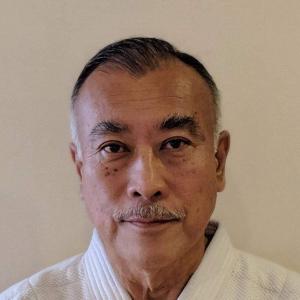
Izawa Kei (井沢 敬)
International Aikido Federation (IAF)
Vice Chairman
Aikido 7th dan with over 53 years of aikido experience
Nowadays, people practice Aikido in about 140 countries and territories.
International Aikido Federation Summits and international seminars take place regularly, and aikido demonstrations are held at international multi-sport events.
Aikido is a unique martial art that has no competition and it is best enjoyed by training with a partner. In spite of all the different languages, we are all united by one common language which is aikido, and training together with friends from all over is the best way to establish friendships and learn from each other.
The Iwama area of Kasama City is one of the four major places closely connected to aikido and is a holy place for aikido practitioners, one would definitely like to visit.
"Iki-iki Ibaraki Yume Kokutai" National Sports Festival of Japan 2019 was a major honor for aikido people of the world who could participate and perform a demonstration in front of Doshu and aikido legends. Conducting a demonstration in Kasama City would have a very valuable meaning to many overseas aikido practitioners.
The center for aikido is now Aikikai Aikido Hombu Dojo in Tokyo, but Iwama will always continue to be the spiritual pillar for aikido. When you talk about Budo Tourism, Iwama is a place with significant value for aikido practitioners all over the world. If Kasama City could add more infrastructure to welcome overseas aikido visitors and host some events for aikido, I can imagine a great contribution to local globalization. Also providing all public schools with aikido training, as one of the places deeply connected to aikido, could generate more future legends coming from Kasama city.
Kasama city could also invite students from all over the world to study aikido in Iwama and interact with local aikido practitioners, which would definitely open more windows for globalization.
The Aiki Shrine, Dojo, and Practice
Memories of Live-in Students
In the old days, uchi-deshi lived in the dojo. They underwent training while helping the teacher manage the dojo.
Since around 1970, people from overseas have also come, and so far, practitioners from more than 30 countries have lived and trained here. Many of them kept coming back. There were times when the dojo hosted more than 100 people in one year.
We asked two people who had practiced aikido as live-in students about their memories of that times.
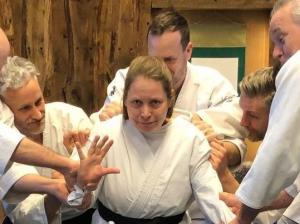
Pia Moberg
Head of the Riai Aikido Dojo
Gothenburg, Sweden
Aikido 6th dan with over 44 years of aikido experience
Self-introduction
I work as a teacher in the field of intercultural communication and run an aikido dojo with about 200 students, where I teach three to four times a week. I also write books about Japan and aikido for children.
I am very much looking forward to visiting Kasama City in April 2023 on an international cultural and aikido exchange tour that I am organizing for young aikido leaders.
On training in Kasama city
Since I first trained under Saito Morihiro Sensei in Iwama in 1988, I have come back and lived and trained in Iwama many times.
Life at the dojo was busy, and I didn't have much free time, but I remember when I visited a public bath on the way up Mt Atago. I also went to the pottery and music festivals in Kasama. I also enjoyed going shopping by bicycle. I still have the T-shirt I bought on my first visit to Iwama.
Particularly memorable moments
At the 70th birthday celebration of Saito Sensei, who was my teacher at the time, he cut a birthday cake with a sword.
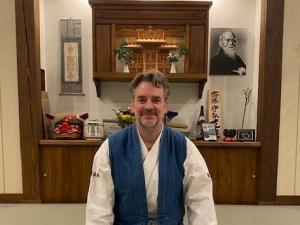
Mark Larson
Head and Chief Instructor of the Minnesota Aiki Shuren Dojo
Minnesota, USA
Aikido 6th dan with over 30 years of aikido experience
Self-introduction
As a full-time faculty member at North Hennepin Community College, I teach English Writing to students from other countries and general education courses in Global & Cultural Studies such as Japanese Culture and Aikido. I live in a rural city in Minnesota, which, like Iwama in the old days, has rich nature with lots of orchards and fields.
Thanks to aikido, I have met people from all over the world, and I continue to practice aikido every day, sharing Traditional Aikido precisely as I learned it in Japan with as many people as I can.
On training in Kasama City
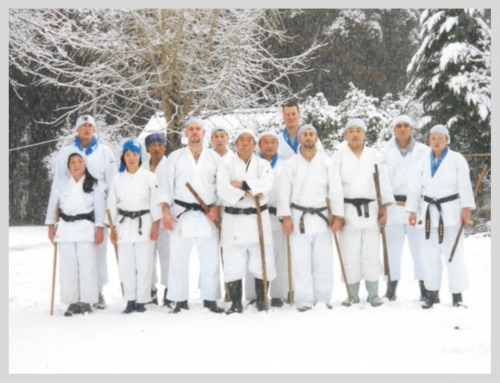
I began aikido with Kawabe Shigeru Sensei in Akita Prefecture as a university study-abroad student in 1992. The following year, I went to Iwama for the first time for the Aiki Shrine Grand Festival with him. I would then commute to Iwama to stay in the dojo and train under Saito Morihiro Sensei a dozen times or more. I moved to Iwama full-time in 1997 and kept learning and practicing aikido while working for the Iwama Town Board of Education until 2001.
Living conditions were simple and austere. Even so, the dojo could be filled with aikido practitioners from 30 countries at one time as Iwama was the mecca of aikido for us.
Interaction with the local community
I taught English at elementary and junior high schools, translated town brochures, and wrote articles for the local newsletter Koho Iwama.
I also participated in town events and the Aiki Shrine Festival, and took part in various international exchange activities and aikido events at the Iwama Dojo, Budokan, and Community Center.
Impressions about the Kasama City area
The area has really developed with more stores and businesses than in the old days.
The Aiki Shrine and the founder's dojo used to be more hidden in the forest; however, now they are lit up and even open to the public.
Information
The founder's dojo is now called the Ibaraki Branch Dojo and training sessions are held every day except for national holidays.
If you became interested in aikido, which originated here and has spread throughout the world, please come to observe and try it yourself.
Aikikai Foundation Ibaraki Branch Dojo
Address: 27-1 Yoshioka, Kasama City, Ibaraki Prefecture
TEL: 0299-45-6071
Training hours:
Weekdays: 7 pm, Saturdays: 5 pm, Sundays: 10 am
※This is an edited version of an article that appeared in the March 2023 issue of "Kasama Magazine."
問い合わせ先
- 2023年3月3日
- 印刷する
